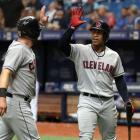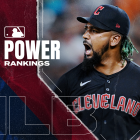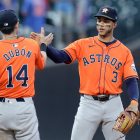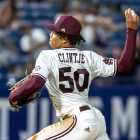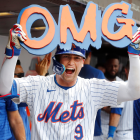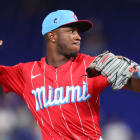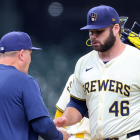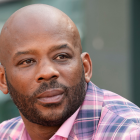In baseball, complacency can be a killer. When a team wins the World Series, there's a naturally strong urge to want to run it back with the same cast of characters the following season. Turns out that approach doesn't work nearly as well as teams would hope.
Gauging the impact of standing pat gets tougher the more we loosen our guidelines. Take Cleveland. The best team in the AL Central by a wide margin over the past three seasons has won three straight division titles, but with varying results in the postseason: One trip to the World Series, followed by two straight early exists in the ALDS.
Meanwhile, Cleveland ran out the fourth-oldest group of position players and the sixth-oldest assemblage of pitchers last season. Combine all that with an ignominious ALDS sweep and maybe a little battle fatigue, and you can see how change would be in order. Viewed in that light, it's easy to understand why Cleveland would at least entertain the possibility of trading one of its aces -- either two-time Cy Young winner Corey Kluber, or up-and-coming righty Trevor Bauer. Trade one for a dynamic young outfielder or two and you can address the team's biggest weakness, while still running out most of the pitchers who made up 2018's best rotation in baseball.
That trade never materialized. And All-Star left fielder Michael Brantley bolted for Houston. And Cleveland did almost nothing else to address what might be the weakest outfield in baseball.
That sequence of events, combined with franchise shortstop Francisco Lindor suffering a calf injury that will likely force him to miss the start of the season, has led to this: The team trying for a fourth straight AL Central title might have the thinnest Opening Day lineup of any legitimate contender. Making matters worse? Lindor's injury aside, this sad state of affairs was entirely preventable.
Here's Cleveland's projected Opening Day lineup with Lindor on the shelf, courtesy of Roster Resource. I've included Steamer projections for the starting nine to show what we might expect.
| Player | Position | Projected slash line |
|---|---|---|
Leonys Martin | CF | .248/.308/.388 |
Jason Kipnis | 2B | .248/.322/.403 |
Jose Ramirez | 3B | .284/.374/.513 |
Carlos Santana | DH | .251/.367/.453 |
Jake Bauers | 1B | .245/.338/.415 |
Tyler Naquin | RF | .262/.322/.408 |
Roberto Perez | C | .213/.305/.355 |
Greg Allen | LF | .249/.314/.350 |
Yu Chang | SS | .217/.280/.360 |
That's one superstar, one solidly above-average hitter, two hitters right around league average, and a whole lot of problems.
Even if Lindor's back by mid-April, this all looks like a lot of heartache for nothing. Let's give Cleveland the benefit of the doubt at second base, where Jason Kipnis does have a track record of success, even if his numbers have been down the past couple years. That still leaves ugly situations at catcher (where Perez hit .168/.256/.263 last season and newly acquired Kevin Plawecki ranked as one of the worst receivers in the game as a backup) and outfield ("Martin! Naquin! Allen!" isn't a jingle that's going to sell many season tickets), as well as some concerns in the bullpen with Cody Allen and Andrew Miller flying the coop.
Now consider some of the talent that's gone by the boards at those positions so far this winter:
Catcher
J.T. Realmuto: The Phillies gave up a lot of young talent to reel in this former Marlin. But Realmuto is 27 years old, he's the best all-around catcher on the planet, and he'll likely make about $20 million combined over the next two seasons. For an organization so obsessed with getting younger and holding the line on salaries (read: owners lining their pockets with tens of millions of dollars in profits), Realmuto would have been an absolutely perfect fit. Then again, it's not clear that Cleveland would've even had the kind of high-upside, major league-ready, pre-arbitration talent that the Marlins craved in such a deal.
Yasmani Grandal: Whether or not the specific rumors of a $60 million offer were true, Grandal becoming available for the cost of just a one-year contract should've sent Cleveland's entire front office into Defcon 1 mode, given the all-around skill set that made Grandal second only to Realmuto last season for Wins Above Replacement among catchers. There's ostensibly no risk for a one-year, $18.25 million deal, unless your team considers spending real money for premium talent to be the biggest risk of all.
Robinson Chirinos: Signed a one-year, $5.75 million deal with the Astros. The ninth-best hitting catcher in baseball (minimum 300 plate appearances) and sixth-most prolific home-run hitter at the position last season could've formed a logical offense-defense platoon with Perez, at a modest cost.
Wilson Ramos: One of the most potent bats in the league at his position, with a better glove than Chirinos. Two years, $19 million wouldn't have been hard to beat if winning were the top priority.
Bullpen
Cody Allen: Moderate but still noticeable slippages in fastball velocity, strikeout rate, and walk rate, as well as a whole bunch of heart attack-inducing innings, prompted Cleveland to move on from its primary closer of the past five seasons. This one's highly forgivable, given that Allen was a replacement-level pitcher in 2018.
Brad Boxberger: Last year's Diamondbacks closer is now the Royals' 2019 closer, for the low, low price of $2.2 million. Unfortunately Boxberger paired his terrific strikeout with some of the highest walk and home-run rates in baseball. No big loss.
Brad Brach: The Cubs scooped up the 32-year-old former All-Star on a one-year, $4.35 million deal. If he's even 85 percent as good as he was in that marvelous 2016 campaign, the Cubs got a steal, and Cleveland's one of 29 teams that missed the boat.
Zach Britton: Three years, $39 million for the most prolific groundball pitcher in the game, but also a pitcher who's not the strikeout pitcher he once was. A reasonable omission, even if Britton did fortify a top AL rival's bullpen instead.
Jeurys Familia: Returned to the Mets on a three-year, $30 million contract. Familia's still one of the best relievers in the game, and could have formed a devastating one-two punch in Cleveland's pen with incumbent lefty Brad Hand.
Kelvin Herrera: Plenty of closing experience, but coming off an injury-plagued 2018 season. Still, with every team swimming in cash from Internet revenue and gobs of other sources, topping a two-year, $18 million deal would've been no sweat for any franchise, Cleveland included.
Greg Holland: Awful last year, but that might've been a function of signing so late in the spring. Given his impressive track record, he was well worth a little more than the one-year, $3.25 million pact he got from Arizona.
Shawn Kelley: Fifty strikeouts against just 33 hits and 11 walks over 49 innings last season. Cleveland is in good company in missing out on the 34-year-old right-hander, given the modest $2.5 million deal he pulled in from Texas.
Joe Kelly: An absolute firebreather, Kelly got a three-year deal, and three-year deals for relievers are risky.
Andrew Miller: He's a notch below the planet eater he resembled in 2016, but Cleveland appears to have made up its mind not to re-sign their star lefty well before the Cardinals lured him over for $25 million.
Adam Ottavino: Another three-year deal, though Ottavino was phenomenal in 2018, and was due for some relief upon leaving the funhouse mirror that is Coors Field.
David Robertson: Unimpeachable track record of performance and durability. Signed for a bit less than comparable pitchers (two years, $23 million). Any contender would've scored in landing him.
Trevor Rosenthal: Meh.
Joakim Soria: A solid veteran right-hander, but there were many others like him on the market.
Justin Wilson: Got two years, $10 million from the Mets, but Cleveland was in better shape on the left-handed side than some other contenders already.
Infield
Brian Dozier: OK, one infield name to discuss. Dozier looks like one of the ripest bounce-back candidates in baseball, a real 30-homer threat not far removed from being an elite hitter. For a one-year, $9 million investment, Cleveland could have upgraded at second base; if the club insists on being wedded to Kipnis, Dozier could've manned second, pushing Kipnis into an outfield timeshare.
Outfield
Michael Brantley: Dr. Smooth was beloved in Cleveland. But a recent history of shoulder injuries, Brantley landing on the wrong side of 30, and the $16 million-a-year price tag knocked his former employer out of the bidding. A decade ago, he might've pulled in a four-year deal.
Avisail Garcia: One year removed from hitting an excellent .330/.380/.506, surprisingly top-notch baserunning speed, just 27 years old, and cost a mere $3.5 million. Monumental whiff by Cleveland and everyone who isn't the Rays.
Marwin Gonzalez: He's still out there, and he could fill an outfield spot, provide an offensive upgrade, and also beef up the team's depth and versatility. Another team less concerned with pinching pennies will probably bid more.
Billy Hamilton: Depends what kind of appetite Cleveland had for a fly-chasing outfielder with world-class speed and the batting prowess of a blind emu.
Andrew McCutchen: Got a market-value deal.
A.J. Pollock: They weren't going to outbid the Dodgers, but letting him go elsewhere for $55 million still feels like a mistake, and a contract number that looks like it came from 20 years ago.
Bryce Harper: HAHAHA!
A few caveats apply here. First, hindsight is 20/20. We can't just walk through all the players who signed with or got traded to other teams, add 10 cents, and assume Cleveland could have gotten their man/men. Second, you could perform this same exercise for any number of teams of course, from the huge-revenue Cubs to the smaller-revenue, mesmerizingly tight-fisted Rays. In a baseball landscape rife with skinflints, Cleveland hardly stands alone.
Still, the bargain prices of this winter's freely available talent, combined with some easy-to-fill holes and a roster that still has plenty of stars would've seemed to set up perfectly for Cleveland to do some productive shopping. Meanwhile, the Twins bought low on power hitters and have plenty of promising young talent, while the White Sox could get frisky if they were to land Manny Machado and more between now and opening day.
The AL Central is still Cleveland's for the taking. But the division could get far more interesting than it should, because yet another team is doing far less than it could.









